
Image by Aaron Smith, © All Rights Reserved.
Welcome to the Brink of Everything
A Note from Parker: A number of the essays in my new book first appeared as columns at On Being Studios. My profound gratitude to Trent Gilliss and my dear friend Krista Tippett for inviting me to become a columnist, putting me in the company of writers and readers who encourage the very best of online conversation. Special thanks to Mariah Helgeson, senior editor at On Being, whose extraordinary editorial skills have helped me become a better writer. I will not mention the fact that she’s less than one-third of my age. Given her level of expertise, this seems extremely unfair!
Every day, I get closer to the brink of everything. We’re all headed that way, of course, even when we’re young, though most of us are too busy with Important Matters to ponder our mortality. But when a serious illness or accident strikes, or someone dear to us dies — or we go to a class reunion and wonder who all those old people are — it becomes harder to ignore the drop-off that lies just over the edge of our lives.
I’ll be nearly 80 when this book is published, so it shouldn’t surprise me that I can sometimes see the brink from here. But it does. I’m even more surprised by the fact that I like being old.
Age brings diminishments, but more than a few come with benefits. I’ve lost the capacity for multitasking, but I’ve rediscovered the joy of doing one thing at a time. My thinking has slowed a bit, but experience has made it deeper and richer. I’m done with big and complex projects, but more aware of the loveliness of simple things: a talk with a friend, a walk in the woods, sunsets and sunrises, a night of good sleep.
I have fears, of course, always have and always will. But as time lengthens like a shadow behind me, and the time ahead dwindles, my overriding feeling is gratitude for the gift of life.
Above all, I like being old because the view from the brink is striking, a full panorama of my life — and a bracing breeze awakens me to new ways of understanding my own past, present, and future. As one of Kurt Vonnegut’s characters says in Player Piano, “out on the edge you can see all kinds of things you can’t see from the center.”
Looking back, I see why I needed the tedium and the inspiration, the anger and the love, the anguish and the joy. I see how it all belongs, even those days of despair when the darkness overwhelmed me. Calamities I once lamented now appear as strong threads of a larger weave, without which the fabric of my life would be less resilient. Moments of fulfillment I failed to relish in my impatience to get on to the next thing now appear as times to be recalled and savored. And I’ve doubled down on my gratitude for those who’ve helped me along with love, affirmation, hard questions, daunting challenges, compassion, and forgiveness.
Looking around at our shared world, its suffering and its promise, I see the courage with which so many live in service of the human possibility. Old age is no time to hunker down, unless disability demands it. Old is just another word for nothing left to lose, a time of life to take bigger risks on behalf of the common good.
Looking ahead to the day when I go over the brink to what Leonard Cohen calls our “invincible defeat,” all I know for sure is that it’s a long way down. Will I spread my wings and fly, fall wordless as a rock, or flame out like a screaming banshee? I have no idea.
But of this I am certain: that I’ve come this far makes me one of the lucky ones. Many people never had a chance to see the view from where I stand, and I might well have been among them. I’ve known days when the voice of depression told me that death was a better idea than trying to carry on. For a long time, I bored my doctors, but over the past fifteen years, I’ve become a “person of interest” to several kinds of specialists.
So I’m not given to waxing romantic about aging and dying. I simply know that the first is a privilege and the second is not up for negotiation.
In 2004, shortly after my 65th birthday, I spent an evening with friends who gave me a hard time about my generation’s motto, “Never trust anyone over thirty.” Amid jibes like “You’ve exceeded your shelf life by more than twice,” someone asked, “Seriously, how do you feel about getting old?”
“I’ll let you know when I get there,” I said. “But I can tell you this. The Dylan Thomas poem I loved when I was young — ‘Do not go gentle into that good night’ — no longer speaks to me.”
It was a late summer evening, and we had a lovely view to the west. “Look at that sunset,” I went on. “It’s beautiful, and it keeps getting more beautiful before things go dark. If that sun began to rise right now, we’d be shrieking, Apocalypse!, knowing that our solar system had gone bonkers, that the laws of nature had failed.
“I don’t want to fight the gravity of aging. It’s nature’s way. I want to collaborate with it as best I can, in hopes of going down with something like the grace of that setting sun. For all the wrinkles and worry lines, it’s a lovely thing simply to be one of those who’s lived long enough to say, ‘I’m getting old.’”
Today, I smile at the notion of “collaborating with aging.” It reminds me of the exchange between the nineteenth-century transcendentalist Margaret Fuller and the writer Thomas Carlyle. “I accept the universe,” proclaimed Fuller. “Gad! She’d better,” replied Carlyle. I’m with her in this little spat, though I do admire his wit.
We have no choice about death. But we do have choices to make about how we hold the inevitable — choices made difficult by a culture that celebrates youth, disparages old age, and discourages us from facing into our mortality. The laws of nature that dictate the sunset dictate our demise. But how we travel the arc between our own sunrise and sundown is ours to choose: Will it be denial, defiance, or collaboration?
For many years, writing has been one of my ways of collaborating with life. For me, writing is not about filling my head with ideas, then downloading them to the page. That’s not writing; it’s typing. Writing is an unfolding of what’s going on inside me as I talk to myself on a pad of paper or a computer, a version of talk therapy that requires neither an appointment nor a fee. This book, my tenth, is one fruit of my collaboration with aging — an offering from a fellow traveler to those who share this road, pondering as they go.
A few words about “grace, gravity, and getting old.” I’m writing this prelude in Santa Fe, New Mexico. For over a decade, my wife and I have come here in the late spring for a couple of weeks of hiking, writing, napping, eating Southwestern food, and enjoying spectacular sunsets.
At my age, the napping, eating, and sky-gazing are no stretch. But out on a mountain trail, I feel both grace and gravity more keenly than when I first came here in my mid-60s.
The grace is that I have the health and resources to get myself out to the high desert; that, after a couple of days, my heart and lungs are still able to adjust to the 7,000-foot difference between Santa Fe and my midwestern home; that I can stand at a trailhead and still feel confident about getting partway up, maybe even to the top of a trail that climbs from 9,000 to 10,000 feet; that every foot of the way I’m surrounded by beauty that a lot of people never get a chance to see.
But as I climb, gravity kicks in. I hike more slowly than I used to, stopping to catch my breath more often. I have to be more attentive to where I’m putting my feet lest a momentary imbalance pitch me into a fall. The tug of gravity is an inescapable part of aging. As they say, “Everything goes south.” Energy, reaction time, muscle tone, the body itself — they’re all headed back into the earth, as far south as it goes.
There’s no antidote for the gravity that takes us to the grave. But there is a countervailing force called “levity.” According to an online etymological dictionary, “In [the] old science (16th–17th Century), [levity is] the name of a force or property of physical bodies, the opposite of gravity, causing them to tend to rise.” For us, of course, levity means the kind of humor that eases the burden of life’s gravitas, the kind G. K. Chesterton had in mind when he said, “Angels can fly because they can take themselves lightly.”
As Leonard Cohen writes in one of his many memorable verses, “Well, my friends are gone and my hair is grey / I ache in the places where I used to play.” It’s all true, and the first few words are heavy. But the laugh that comes with the second line lightens the load.
Poetry also lightens the load by lifting weighty things using the leverage of metaphor. Here’s an example from the poet Jeanne Lohmann, who wrote with insight and elegance until her death at age ninety-three. Her poem helps me deal with the sense of heaviness about aging that occasionally comes over me. It also helped inspire me to write this book — a meditation on aging in which I’ve tried to be true to gravity, to grace, and to the voice of my own experience in a way that invites the reader to listen to his or hers:
Invocation
by Jeanne LohmannLet us try what it is to be true to gravity,
to grace, to the given, faithful to our own voices,
to lines making the map of our furrowed tongue …(Excerpted from Shaking the Tree: New and Selected Poems. Read the full poem here.)
I hope that the words on these pages refuse “solemnity and slogans” and “honor what hides and does not come easy to speech.” My words are no more than “feathers that fly,” but that does not matter. What matters is that they fly “in a holy direction,” the direction of life.
My first book came out in 1979 when I was 40, my ninth book in 2011 when I was 72. So on average it’s taken me three or four years to write a book. Every book has felt like a marathon, and after I finished number nine, I felt certain I didn’t have another long-distance race in me.
Toward the end of 2015, I was talking with Sheryl Fullerton, my longtime editor and friend, who wondered if I was working on a new book. “No,” I said, “I don’t have the energy for it. But I’m really enjoying short-form writing — brief essays and a little poetry.”
Sheryl asked, “Have you thought about gathering those essays, along with some of your poetry, editing them, writing some new material, and weaving all of it into a book, the way you did with Let Your Life Speak?” The conversation that followed is a good example of how we get by with a little (or a lot) of help from our friends, just as the Beatles claimed:
Me: No, I haven’t. I mean, a book has to be about something. My short pieces have been all over the map.
Sheryl: Um, that’s not true. I know, because you’ve sent me a lot of those pieces over the last few years.
Me: And you think there’s a theme running through them?
Sheryl (after a brief silence): Parker, do you ever read what you write?
Me: Of course not. Why should I? I write the stuff. But, OK, I’ll bite. What, pray tell, have I been writing about?
Sheryl: Getting old! That’s what you’ve been writing about. Didn’t you know that?
Me (lights blinking on in my brain): Well, no . . . But now that you mention it, a book on aging might be interesting…Wow, am I ever glad I had that idea!
Thus was conceived this book, in which I’ve tried to craft a many-faceted reflection on aging from twenty-four brief essays and a number of poems, including some of my own. The book is not a “guide to” or “handbook for” getting old. Instead, it’s me turning the prism on my experience of aging as a way of encouraging readers to do the same with theirs. We need to reframe aging as a passage of discovery and engagement, not decline and inaction.
Since we’re all aging all the time — if we’re lucky — I hope the book will resonate not only with my age-mates but with people not yet certifiably old. After all, there are young people whom we rightly call “old souls.” I think, for example, of my 27-year-old granddaughter, Heather Palmer, who is also one of my best friends. The journey we’ve shared since the day she was born has opened my eyes, mind, and heart to so much.
I turn the prism seven times in the course of these pages, refracting my experience of aging in a different light with each turn:
I. The View from the Brink: What I Can See from Here probes some things I’m learning as I age, especially the importance of keeping my eyes open to the experience and asking the right questions about it.
II. Young and Old: The Dance of the Generations focuses on creative engagement with the young. When young and old are connected like the poles of a battery, the power that’s released enlivens both parties and helps light up the world.
III. Getting Real: From Illusion to Reality reflects on the spiritual life, which I understand as an endless effort to penetrate illusion and touch reality — a vital task at any age and an imperative for aging well.
IV. Work and Vocation: Writing a Life is about the voice that calls to many of us, saying, “Whatever your paid work may be, this is what gives you life” — the voice that has long said to me, “Write!” As we age, it’s important to get clear about the difference between the jobs by which we make a living and the callings, or vocations, by which make meaning. Many elders leave or lose their jobs. But it’s possible to follow a calling to the end of life, and continue to make meaning at a time when it’s much needed.
V. Keep Reaching Out: Staying Engaged with the World makes a case for the importance of elders never ceasing to care about our shared world, and acting on what we care about — if only in our minds and hearts and via words spoken to people close at hand.
VI. Keep Reaching In: Staying Engaged with Your Soul is about the centrality of inner work done in silence and solitude. Knowing yourself and sinking your roots into the ground of your being are critical in old age. Becoming comfortable with silence and solitude can ease the final transition from life to death — a journey we must make alone back into the silence from which we came.
VII. Over the Edge: Where We Go When We Die answers the age-old question, “What happens to us after death?” My original marketing plan was simple: “Want the answer? Buy the book.” But my publisher nixed that idea — something about truth in advertising. I’ll simply say that, after reading Chapter VII, you’ll know where heaven is, though I may be a little off with the longitude and latitude.
Welcome to the brink of everything. It takes a lifetime to get here, but the stunning view and the bracing breeze in your face make it worth the trip.
This prelude is excerpted from On the Brink of Everything: Grace, Gravity, and Getting Old. It is printed with permission from Berrett-Koehler Publishers, 2018, www.bkconnection.com.

